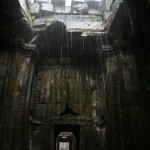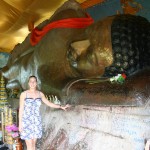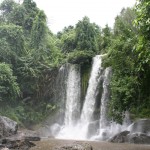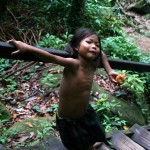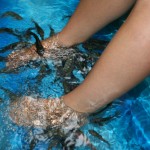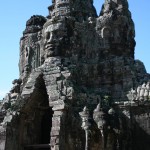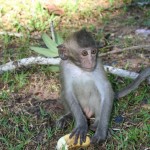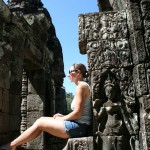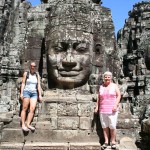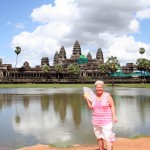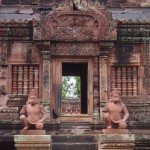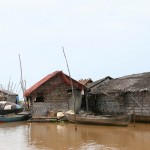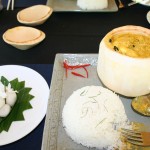13/6/2011
Ho Chi Minh…
Checked into our flight to Siem Reap with no hassles. Boarding the plane I noticed there weren’t many people getting on (14 in total including mum and I, not including airplane staff). We were getting onto a little propeller plane, here the stairs folded down from the side of the plane.
Being the wet season, we flew through a lightning storm (we weren’t hit or anything) and being in a little plane, this meant that it was a bit of a rough trip.
We arrived at Siem Reap at about 6pm. We walked across the tarmac into a gorgeous but very small airport where bought our tourist visa. The visa cost $40US but we only had vietnamese and australian money, we asked if we could pay in aussie dollars and handed him a $50. He said “thats ok” and then wouldn’t give us change. Sneaky bugger.
So then we went through ‘immigration’ here the guy looked at our passports then handed them back, then passing through customs there was no one there to check our declaration forms so we wandered on through. Once we got into the main arrival hall our hostel dude was there to pick us up… in a tuk tuk!!! So we had a nice 20 minute tuk tuk ride to the hostel..
We spent the night in a very cute hostel with some very friendly staff. I got some great advice on some places to go and how to get there!
14/6/2011
We woke up bright and early, had some brekky and the hired a tuk tuk to take us to our hotel (the tour module I booked had us in a nice fancy hotel for 3 nights). So we checked into Casa Angkor and straight away hired a driver to take us to Kulen mountain (we were in a hurry to get going as we knew Kulen mountain closes to visitors at 11am).
Kulen mountain was about 1.5 hours drive away, the last half hour of which was up steep countryside along a very bumpy road. We noticed that many of the trees in this last section each had the same painting on them. It looked kind of like a pictogram of a person with a stick below it (not attached). According to our guide these are markers indicating which direction you should go, and not to go the way it is not pointing as that way is unsafe. As we had passed a sign saying the area was mined (land mined) I had interpreted the pictogram as a warning indicating there were mines. Whichever interpretation you go with, don’t go past the tree line!
At Kulen mountain we wandered through a small village before heading up the big staircase to the pagoda at the top. Kulen mountain has huge rocks everywhere, and at the top of one of these rocks a large reclining buddha has been carved into the stone, and then a pagoda built around it. It was really cool to see a pagoda in the middle of the jungle. The only annoying thing was that there were beggars, little children and other randoms everywhere asking for money. Particularly the children, they follow you around and in a whiny voice say “Just one dollar madam, one dollar”.
We headed part way down Kulen mountain and took a right turn to check out the waterfall. Randomly in the middle of a little village was a beautiful waterfall, probably about 10 metres high. When we got there we were at the top, so we found a little dirt track and followed that down to the bottom. It was stunning! Many people were swimming in it, but we weren’t quite that keen. We did give our feet a wash, which was very refreshing.
Along the drive back we stopped a few times to take some pictures. One of the road side stalls was selling bananas, but not just stock standard yellow bananas, she had yellow, green, orange-red and red-brown. We took a photo because we thought it looked cool. The lady was so lovely she gave us a red-orange banana to try for free. It was delicious!! But no different in flavour to a normal banana. However, bananas in the tropics are smaller and much sweeter than back home.
By the time we got back to the hotel it was around 2pm. We really wanted to do something interesting, but unfortunately most afternoon tours had already started. We really wanted to do a cooking class, but it was too late in the day. (we didn’t go to the temples of Angkor Wat etc because that was part of the tour that would be starting in the morning).
So we caught a tuk tuk to the old market in the city centre. There were some gorgeous little bits and bobs for sale around the markets, and we had a lovely wander around. At one little stall they were offering fish foot massage. This is where there is a tank of little fish, and you put your feet in the tank and the fish eat off all the dead skin. So I gave it a whirl.
There was one tank with little fish and they weren’t too bad. It tickled a bit but you could get used to it. Then it was time to test out the slightly bigger fish. I tried so hard but each time I squealed and pulled my feet out of the water. I have insanely ticklish feet, and not matter ho many times I tried, I couldn’t keep my feet in the water for longer than about 30 seconds!! If you ever get the chance, its worth trying!
A little further down the street we stopped again, but this time for a normal massage. We had a 10 minute foot massage, and it was soooo relaxing!
As it got into evening we found a great little street restaurant where we sat down and ordered some traditional Khmer food. We had beef amok. It was so tasty! The Cambodians use more meat and less vegies in their dishes than the Vietnamese people. They also have a much smaller selection of vegies that they use. As it was happy hour, I also took the opportunity to enjoy a cocktail…for $1.50 why wouldn’t you?!? The restaurant also had a traditional Apsara dancing show, so e watched some of that. It was beautiful to watch, and they had amazing costumes but the movements were so slow. In an hour we only saw 3 different dances.
We ended the evening with a little wander around the night market.
15/6/2011
Our guide Chanra picked us up from the hotel at 8am, and we headed straight to Angkor Thom. Angkor Thom was one of the ancient cities. It is surrounded by a huge moat, we entered the city via the south gate. This was a big bridge, and both bannisters had a big long snake running the length of the bridge, the snake is called Naga. Then on the left were ‘gods’ and on the right were ‘demons’ and they were each pulling the Naga to represent the fight between good and evil. This is a common theme on several of the buildings.
Inside the moat you first need to travel several hundred metres before getting to the centre of the ancient city. On this drive we spotted some monkeys, so we pulled over to have a look and take some pictures. Mum bought some bananas that we could feed them too. So I held out a banana to the papa monkey, it grabbed it, threw it on the ground and then ran at me and tried to climb up my legs. I screamed, and hid behind the guide! Its rather terrifying to have monkey running at you! I can tell you now the chance of it running to you for a cuddle and very slim! We fed some of the baby monkeys..they tried to run and climb up me too, after this I kept a good distance from the monkeys and stayed close to the guide who was holding onto a stick to scare them away if they got too close (not to hit them, but waving the stick at them was enough to keep them away).
Once in the centre-ish of the ancient city there are a number of amazing structures including: Bayon Temple, Baphoun Temple, Phimeanakas temple, the terrace of the elephants and the terrace of the leper king. Everything is constructed from volcanic rock and sandstone. The foundations are typically made from volcanic rock as it is very hard, on top of the foundations, all the walls roofs, etc are made of the sandstone. Being a softer stone the sandstone was used so that they were able to carve their decorations into it. Many of the carvings illustrate buddhist or hindu beliefs (depending on which temple you are in), some illustrate historical events, and some have sanskrit, the old writing which no one can read any more. On many of the sandstone blocks there were 2 holes. The sandstone blocks all came from Kulen mountain, they were transported down the river, and then for the last section they were dragged by elephants. Two sticks were put in each block, and this somehow provided the means for the elephant to drag it. I would try to describe the buildings, but I think that words can’t really describe the amazing and intricate designs, so you will have to look at the photos.
After exploring the city of Angkor Thom we headed to the ‘jungle temple’, Ta Prohm. This temple was used in Tomb Raider, and it is the one that has the trees growing on and into the stonework. The tree that grows on the buildings is called the Spong Tree. As tourists we love seeing this temple and we all think it is amazing, its probably the favourite of many. Unfortunately though, the trees are causing a lot of damage and as they are grow they are slowly destroying the buildings. Its a bit of catch 22, they want to restore the buildings and keep them well maintained, but the trees that cause the damage are what makes it the tourists’ favourite.
I’m going to watch tomb raider again when I get home to see if I can spot Ta Prohm in it.
After walking through Ta Prohm we were brought to a khmer restaurant near the ancient lake Sra Srang. It was yummy food – as usual. As we had been walking around in he blazing hot sun, it was so good to sit in the shade, near a fan and have a cold drink!
After lunch we headed to the most famous of all the temples in the Siem Reap area: Angkor Wat. Angkor Wat is a single temple with 5 towers (theres always odd numbers of things as odd numbers are considered lucky). Entering the main gate there was a very long centre causeway heading towards the building with the towers. We climbed many of the towers and it was absolutely awesome. The bas reliefs carved into the galleries are very detailed and cover many amazing stories. The detail that goes into every aspect of every building is astonishing! Again, words can’t really describe it.
After having spent the entire day in full sun, I must admit I was a smidge sunburned on my shoulders. To aid in the cooling off process, we had a swim in the pool once we had been delivered back to the hotel. It was incredibly refreshing. We sat by the poolside and ordered a drink. I ordered an iced tea…and I got a pot of cold black tea!! It wasn’t too bad, but it certainly wasn’t what I had hoped for!
For dinner we headed to pub street and went to a restaurant where we ordered a traditional khmer hot pot. You get a butane cooker on your table, and the pot on top of it has a grill plate in the centre where you cook your meat, and that drips down into a saucepan type thing. It is circular with a dome-ish type grill bit in the middle with a little moat around it. You cook the vegies in the moat and the meat on the grill. It was pretty cool, but a bit too much effort. Great to try it once!
16/6/2011
Once again we were picked up at 8am by our guide Chara, and we headed to a temple a little further afield, Banteay Srei. This is the ‘female temple’ and it is decorated with the ‘female divinity’. It is considered by most Cambodians to be the jewel of all the temples. It is a smaller temple, which has been made from pink sandstone, it is absolutely stunning in its intricate design, but mostly because it is the least ruined of each of the temples.
As soon as we got to Banteay Srei, unfortunately for us, it started BUCKETING with rain. So we had raincoats and umbrellas, but had to wait in the entrance hall for the rain to ease before we could head out to the temple. Even in the rain this temple was gorgeous. I just hope the pictures I took can do it some justice.
After this we headed to Banteay Samre, then to Pre Rup. Now having seen so many temples I can’t remember the distinguishing features of each. But as you can expect, they were both amazing. The rain had eased by then so we were able to ditch the raincoats.
After visiting these temples we were dropped off for some lunch. We ate and then set off again headed for he lake Tonle Sap. In a river way that leads to the lake we caught a boat and putted up the river way through a floating village. We saw schools and universities, markets and many houses. The floating village we went through is considered by some locals to be non-traditional. This is because the village is made up of Thai people. They have built their houses as boats that float on the water. The traditional khmer people live in very high stilted houses in another part of the lake. Unfortunately as the wet season is oly just starting there was not enough water for us to visit the traditional khmer villages.
The thai village was still very interesting, and it is astounding to see the conditions that these people live in. There is so much poverty! The kids were again coming up to us and asking for a dollar. But you can’t give money to everyone..you’d be instantly broke!
After visiting the floating villages we headed back to the other side of town where the temples were and climbed the mountain, and then the temple on top of the mountain, Phnom Bakheng to watch the sunset. The temple had 5 tiers and was incredibly steep. Many of the steps going up were about 30cm high but only 10 or 15cm deep, with no hand railings. Up the top there were so many tourists up there hoping to get some good pictures, of course we were included. It was a very pretty sunset. It wasn’t amazing because it was quite cloudy due to al the rain we had had.
For our last night in Siem Reap we went out for dinner and ordered a Cambodian set menu where we got to try some traditional foods. They were all delicious of course!
17/6/2011
Started our morning by packing our bags. At 9:15 we were picked up from the hotel to go to our cooking class. We started the ‘class’ be heading to a house in the local village to see how the poor people live. In a little stilted hut a lady lived with her husband and three kids. They all sleep on grass mats, and cook in a little alcove over a wood fire. On the stove she had a big pot of fried bugs with some kind of crispy fried vegie (looked more like a weed). She also had some grasshoppers, crickets and cockroaches put aside for dinner.
In payment for letting us see how she lived we gave her 2kg of white rice. We also asked our guide if it was acceptable to give them some money, and that was ok, so gave them $10, which is about 2 weeks wages.
In our wander over to this house our guide had pointed out different plants that were used for cooking and for medicine. Interesting what they believe certain plants do. For example, if a young coconut falls from a tree a pregnant woman will eat the fruit because it will help the baby ‘drop’ easily in birth.
In the cooking class we learned to make green mango salad, fish amok and sticky rice with palm sugar It was all pretty easy to make and tasted delicious!!
When the cooking class was over we hired a driver for the afternoon to take us to a few more temples. We went to Preah Khan and Neak Pean. Preah Khan was gorgeous, it was a very long temple and you would walk through short gallery after short gallery. In the centre was a memorial stupa containing the ashes of the king (this is one of the few temples still containing ashes, as many other temples were raided and damaged by the French, and then further damaged by the fighting in the time of the Civil War). It was absolutely bucketing with rain the whole time we were at these to temples, so it was a fairly short lived visit.
So now we are back at the hotel waiting for our lift to the airport and I am blogging as fast as I can to upload this while I still have free internet.
I hope you’ve enjoyed travelling with me and I will see you when I am home

